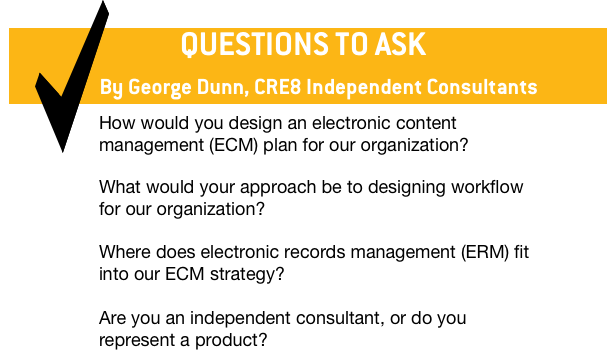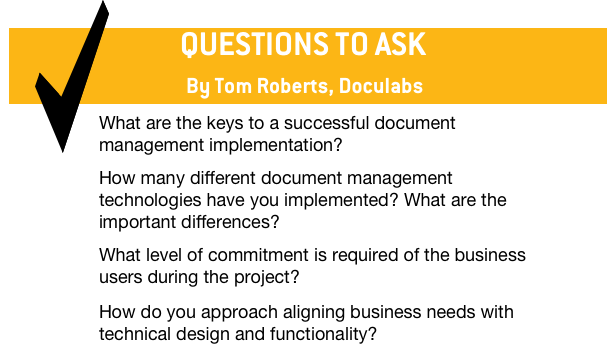
Every so often, I get a call from someone who wants to know if I can help them with their “document management problem.” When I ask some basic questions like, ”What is the problem?” the person hems and haws and eventually states that they have a lot of paper, or that they have a lot of documents, and that people have trouble finding things. "So, how much would it cost to fix it?”
Basically, the callers have not really given a lot of thought about what their problem involves, who is responsible and how serious the problem is. Since I get a number of calls like this, I’m assuming other consulting companies do as well.
So, here are some guidelines for you “first-time callers:”
1. Knowing that you have a “document management problem" is a good start, but document management can mean many things to a consultant. Look at the following areas:
- Is it a problem with paper documents?
- Is it a problem with electronic documents?
- Is it both?
- Does it involve routing documents through a workflow process, like an accounts payable (AP) process?
- Is it a problem with an existing system?
Unfortunately, that old adage, “If your only tool is a hammer, everything looks like a nail,” applies to the consulting business. A consultant should be well-versed in in different technology disciplines, be objective without having ties to vendors and let the “discovered requirements” dictate the possible solutions. Beware of anyone who immediately suggests a solution, “Well, SharePoint handles everything—scanning, workflow, Word docs, PDFs, you name it.”
2. The “document problem” may take some amount of time to define properly. It can be straightforward or highly nuanced leading you in many directions. Try thinking of your “document problem” as a symptom of a greater, more pervasive issue. Many times, I have found the real problem is mismanagement, lack of management or basic inexperience in how things work and operate. If you don’t solve the real issue, you are simply putting a bandage on the symptom. A consultant should be experienced and versed in flushing out the underlying root problems and establishing the problem’s origin. A $200K+ system can be an expensive bandage!

3. When entering an engagement, any consultant, or most of us, would like to scope the effort required and provide you with a pretty solid estimate for the amount of work involved and resources needed, but we can’t do this based on the statement that you have “too much paper and people can’t find anything.” So, be prepared to provide this type of information:
- Is this problem/study for your whole company or a department?
- How many departments will be involved or have this problem (i.e., accounting, human resources, purchasing, contracts, engineering, marketing, sales, etc.)?
- Within each department, how many people will be (or can be) involved? You need at least one subject matter expert (SME), and it is good to have some of the line workers present for each department. I’ve often found during the interview process that the department manager is somewhat out of touch with what really happens and vice versa. Just the process of the two talking together about what they do and how it gets done provides immediate benefits.
4. What type of systems do you use for accounting, human resources, marketing and sales, for example? Second, are you PC or Apple, or both? Third, do you have an existing document management system? What is it, and why is it not working out for you?
5. One very important question is, "What type of paper and electronic documents will be included in the study, such as MS Office, PDFs, etc.?" Be sure to mention and include document types, like engineering drawings, photographs, architectural drawings, forms (that you create or buy) and anything else unusual that may be involved in the “problem.”
6. One area that will drive up the price of the project, both in terms of the consulting project and system to be implemented, is records management–also known as information governance. Many companies that are new to document management do not have a records retention schedule and other governance policies in place to manage the documents once they are in the system. Developing a record retention schedule or governance policies can easily double the cost of a basic project. Some consultants will try to use fear, uncertainty and doubt (FUD) tactics to scare you into doing records management and that it is a well-developed and defined technology. It is not. We have been going at it for over 20 years now with no clear solution in sight. Be careful when you are getting involved in records management or governance technologies and consulting.

7. Another “cost driver” for many projects is that companies do not have consistent naming conventions for their documents and do not have established metadata that helps when searching for documents. In addition to the document title, metadata can be such things as author, date, department or document type (report, photograph, brochure). The cost driver is that a consultant may have to create and document the metadata by interviewing departments. This can take additional time and resources from your people also.
8. One aspect to many “document management problems" is email and email attachments. If email is the primary problem, I suggest you concentrate on hiring an email specialist, as in my opinion, there is really not a good solution to email problems and documents. Many consultants, who are generalists, are not well-versed in email issues, technologies and resolutions.
9. Here are some things you should be prepared for:
- When you add the price for the consulting project to the price of the system, you may already be over budget. If you can, work with the consultant to get some type of rough estimate for the consulting piece and the system piece. Many document management systems are not “stable” in that they may need constant updates and fiddling with, which may be additional information technology (IT) support time and dollars.
- A document management study will require your people to spend a fair amount of time on the consulting project work. There may be interviews, counting and cataloguing paper documents, determining how many and what type of electronic document you have, diagraming workflows on paper or a whiteboard and, generally speaking, being available to the consultant.
- Ask the consultant to provide at least three options in the report with a plus/minus table for each option. Based on the options, ask the consultant to provide a recommendation and include supporting data as to why that recommendation is the best fit.
- Do an in-depth reading of the reports that the consultant provides, not only reading the report but really questioning the results and tabulations. Are there sufficient “options” provided? Why are some numbers “higher than expected?” Why is there data missing in this or that area? What happens if we forego a metadata dictionary?
10. Finally, the result of all of this hard (and expensive) work should be a substantial report and presentation. This is a big decision for you, and it should not be taken lightly. If budget allows, try to have the report presentation delivered in person by the consultant, and depending on the project, set aside a morning and invite as many people as appropriate. Quite often, I spend an additional hour after the presentation with key stakeholders responding to more detailed questions and giving more detail to my recommendations.
These thoughts are really the tip of the iceberg, but I hope they are useful and cause some discussion within our community. Feel free to expand on these with your own ideas and thoughts about not only hiring the right consultant but taking advantage of their knowledge and history
These thoughts are really the tip of the iceberg, but I hope they are useful and cause some discussion within our community. Feel free to expand on these with your own ideas and thoughts about not only hiring the right consultant but taking advantage of their knowledge and history
Bud Porter-Roth has over 20 years of experience as an ECM consultant, with a focus on cloud collaboration, electronic document management, records management and paper document projects. Follow him on Twitter @BudPR or contact him at info@erms.com.




